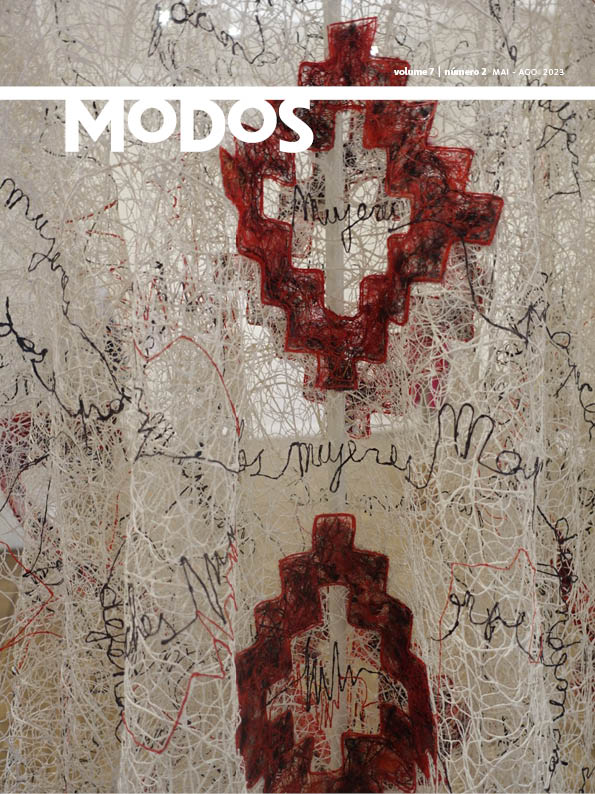Abstract
This article presents the research and curatorial work developed for the exhibition Kwá yepé turusú yuriri assojaba tupinambá: essa é a grande volta do manto tupinambá, held between September and November 2021 at Galeria Fayga Ostrower (Brasília, Distrito Federal) and at Casa da Lenha (Porto Seguro, Bahia). In the show, we departed from the history of the tupinambá capes to reflect on the resumption of their production by these people, the process of colonial domination and their resistance. In addition to questions about how to exhibit sacred objects in contemporary art exhibitions, the article brings reflections on the developments of the show in a year marked by the intensification of political persecution of the native peoples of Brazil.
References
ALARCON, D. F. O retorno da terra: as retomadas na aldeia Tupinambá da Serra do Padeiro, sul da Bahia. 2013. Dissertação (Mestrado em Ciências Sociais) – Instituto de Ciências Sociais, Universidade de Brasília, Brasília, 2013.
ANTENORE, A. "Somos tupinambás, queremos o manto de volta", Folha de S. Paulo, Ilustrada, 1º jun. 2000. Disponível em: https://www1.folha.uol.com.br/fsp/ilustrad/fq0106200006.htm. Acesso em: 10 fev. 2023.
ARANTES, A. O patrimônio imaterial e a sustentabilidade de sua salvaguarda. Resgate: Revista Interdisciplinar de Cultura, Campinas, SP, v. 12, n. 1, p. 11–18, 2006. DOI: 10.20396/resgate.v12i13.8645608. Disponível em: https://periodicos.sbu.unicamp.br/ojs/index.php/resgate/article/view/8645608. Acesso em: 22 fev. 2023.
BRASIL + 500, Mostra do Redescobrimento, 2000. Artes Indígenas: Mostra do Redescobrimento. São Paulo: Fundação Bienal de São Paulo, 2000.
CAFFÉ, J., GONTIJO, J., TUGNY, A., TUPINAMBÁ, G. (Orgs.). Kwá yepé turusú yuriri assobaja tupinambá: essa é a grande volta do manto tupinambá. Brasília: Conversas em Gondwana, 2021.
CRIMP, D. Sobre as ruínas dos museus. São Paulo, Martins Fontes, 2005.
GALLOIS, D. T. Materializando saberes imateriais: experiências indígenas na Amazônia Oriental, Revista de Estudos e Pesquisas, FUNAI, Brasília, v.4, n.2, p. 95-116, dez. 2007.
ESBELL, J. A Arte Indígena Contemporânea como armadilha para armadilhas. Galeria Jaider Esbell, Texto publicado em 9 de julho de 2020. Disponível em: http://www.jaideresbell.com.br/site/2020/07/09/a-arte-indigena-contemporanea-como-armadilha-para-armadilhas/. Acesso em: 25 jul. 2022.
HAILER, M. Genocídio indígena: Entenda o que é o Marco Temporal. Revista Fórum, Direitos, 23 jun. 2021. Disponível em: https://revistaforum.com.br/direitos/2021/6/23/genocidio-indigena-entenda-que-marco-temporal-99307.html. Acesso em: 20 de fev. 2023.
KESTER. G. H. Colaboração, arte e subculturas. In: HARA, H. (Ed.). Caderno Sesc_Videobrasil 2: Arte Mobilidade Sustentabilidade. São Paulo: Edições Sesc-SP e Associação Cultural Videobrasil, 2006, p. 10-35.
KOMPATSIARIS, P. The Politics of Contemporary Art Biennials: Spectacles of Critique, Theory and Art. Londres: Routledge, 2017.
MUSSA, A. Meu destino é ser onça. Rio de Janeiro: Record, 2009.
NAVARRO, E. de A. Dicionário de tupi antigo: a língua indígena clássica do Brasil. São Paulo: Global Editora, 2013.
NDIKUNG, B. S. B. Des-outrização como método: Leh zo, a me ken de za. In: 21ª Bienal de Arte Contemporânea SESC_VIDEOBRASIL: Comunidades imaginadas. São Paulo: Videobrasil; Edições Sesc, 2019, p. 63-67 (Catálogo de exposição).
POÉTICAS AMERÍNDIAS. Kwá yapé turusú yuriri assojaba tupinambá. Lançamento do catálogo da exposição. Youtube, 14 out. 2021. Disponível em: https://www.youtube.com/watch?v=h4lR_SWUm2s&ab_channel=PO%C3%89TICASAMER%C3%8DNDIAS. Acesso em: 10 fev. 2023.
SILVA, D. F. da. Sobre diferença sem separabilidade. In: VOLZ, J.; REBOUÇAS, J. (Orgs.). 32ª Bienal de São Paulo: Incerteza Viva: Catálogo. São Paulo: Fundação Bienal de São Paulo, 2016, p. 57-65.
TINIUS, J.; VON OSWALD, M. (eds.). Across Anthropology: Troubling Colonial Legacies, Museums, and the Curatorial. Leuven: Leuven University Press, 2020. Disponível em: https://www.jstor.org/stable/j.ctv125jqxp.1#metadata_info_tab_contents. Acesso em 26 jul. 2022.
TUGNY, A. A volta histórica dos mantos tupinambás. In: CAFFÉ, J., GONTIJO, J., TUGNY, A., TUPINAMBÁ, G. (Orgs.). Kwá yepé turusú yuriri assobaja tupinambá: essa é a grande volta do manto tupinambá. Brasília: Conversas em Gondwana, 2021, p. 30-43.
UN-DOCUMENTED: Unlearning Imperial Plunder. Direção: Ariella Aïsha Azoulay. Vídeo (34 min.). Disponível em: https://vimeo.com/490778435. Acesso em: 25 jul. 2022.

This work is licensed under a Creative Commons Attribution-NonCommercial-ShareAlike 4.0 International License.
Copyright (c) 2023 Juliana Caffé, Juliana Gontijo

